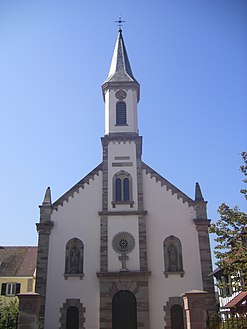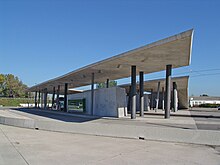Hœnheim
| Hœnheim | ||
|---|---|---|

|
|
|
| region | Grand Est | |
| Department | Bas-Rhin | |
| Arrondissement | Strasbourg | |
| Canton | Hœnheim | |
| Community association | Eurométropole de Strasbourg | |
| Coordinates | 48 ° 37 ' N , 7 ° 45' E | |
| height | 133-151 m | |
| surface | 3.42 km 2 | |
| Residents | 11,215 (January 1, 2017) | |
| Population density | 3,279 inhabitants / km 2 | |
| Post Code | 67800 | |
| INSEE code | 67204 | |
| Website | http://www.ville-hoenheim.fr/ | |
Hœnheim (also Hoenheim , German originally Hönheim ) is a municipality with 11,215 inhabitants (as of January 1, 2017) in the French region of Grand Est in the Bas-Rhin department . It is located in the arrondissement of Strasbourg .
coat of arms
Blazon : D'or aux trois corbeaux de sable et un deux poses ( "black on a golden background three ravens on sand, two and one").
The three ravens come from the legend of the monk Benedict of Nursia , father of the Benedictine monastic rule . St. Benedict lived in an inhospitable, lonely grotto and shared his hermit food with a raven who visited him every day. A jealous priest sent him poisoned bread. Benedict of Nursia gave it to the raven and ordered him to throw it in a place inaccessible to humans.
The raven was then a courtesy, intelligence and loyalty symbol.
geography
Hœnheim is located five kilometers north of Strasbourg on the river Ill and the Canal de la Marne au Rhin .
The neighboring communities of Hœnheim are (clockwise from the north): Souffelweyersheim , Reichstett (both canton Mundolsheim ), an enclave of Bischheim, an enclave of Schiltigheim ( canton Schiltigheim ) and Bischheim . Hœnheim is a member of the Communauté urbaine de Strasbourg (CUS).
The historical center lies on a slope, starting from a 144 meter high plateau that descends to the banks of the Ill, which is 135 meters high on average.
The name Hœnheim comes from this historical center, because the first mention of a place called Hohenheim or Hönheim , in other words, a residence on the heights .
history
Remains and logs found on site confirm the existence of a small settlement in the area of Hœnheim since the Stone Age .
The first mention of the name Hoenheim dates back to 742.
At the end of the 9th century, the village of Hœnheim appears as the property of the Benedictine monastery of Honau , which was founded by the nephew of St. Odilie .
Under the Holy Roman Empire , Hœnheim became the property of the diocese of Strasbourg , which gave its territory to knights or religious communities.
The Holy Chapel , dedicated to John the Baptist , was first mentioned in writing in 1350 .
During the Hundred Years' War , Hœnheim, like many other villages, fell victim to the Ecorcheurs when they tried in vain to take Strasbourg.
The area then passed one after the other to various noble families and finally came to the Uttenheim von Ramstein family in 1457.
In the 16th century, the lords of Uttenheim, repelled by the antics of the clergy (corruption, trade in indulgence, etc.) joined the Reformation , and with them the inhabitants of Hœnheim.
During the Thirty Years' War Hœnheim and Bischheim were victims of abuse of power by both sides.
In 1649 Alsace came to Catholic France through the Peace of Westphalia , which ended the war .
In 1676 the last lord of Uttenheim died without any descendants. A legacy dispute led to the victory of the Rathsamhausen von Stein family over the canons of the great chapter of Strasbourg in 1681. In 1689 the last representative of the main line von Rathsamhausen died and the area of Hœnheim reverted to the Great Chapter of Strasbourg. The Bishop of Strasbourg gave it to the Knight of Chamlay on May 21, 1691, Marshal General of the dwellings and camps of the French armies.
In 1719 Marshal von Chamlay died without any descendants. The Bishop of Strasbourg, Cardinal Armand-Gaston de Rohan-Soubise , transferred the territory to the Klinglin family, who had the full confidence of the royal and local authorities.
The Klinglin family lost their territory in 1790 when the privileges were abolished as a result of the French Revolution of 1789. On March 4, 1790, Hœnheim became part of the new district of Strasbourg in the newly created department. In the same year, at the suggestion of the community of Schiltigheim, the reed was divided (until then public pasture from Souffelweyersheim, as well as Hœnheim, Bischheim, Adelshoffen and Schiltigheim). The division also led to the enclaves of Bischheim and Schiltigheim in the middle of the territory of Hœnheim. On October 2, 1791, all monastery and Klinglin goods were confiscated by the community and sold to the residents. In 1792 the emigrated royalists, allied with the Austrian and Prussian troops, began the struggle for power in France. From October to December 1793 the fighting between the troops of the French Republic and the Austro-Prussian on the line Hœnheim - Griesheim-sur-Souffel - Dingsheim stabilized before the Austro-Prussian troops were pushed back across the Rhine in January 1794 . In 1793 the municipality of Hœnheim became part of the canton of Hausbergen .
Since February 17, 1800 Hœnheim is connected to the new district of Strasbourg.
In 1813, Napoleon's Russian campaign ended in disaster. He managed to return to France with great effort, but the coalition troops followed him. In January 1814, the French troops withdrew to Strasbourg before the attacks by the Cossacks . The Cossacks settled in Hœnheim, Bischheim and Schiltigheim. Napoleon was defeated and banished to the island of Elba . But his escape resulted in the return of the Allied forces, which had just withdrawn. Due to the defeat of Waterloo , General Jean Rapp , who had knowledge of the intentions to annex Alsace, joined Louis XVIII. and fought on the prompt , in front of the doors of Hœnheim. On June 28 and 29, 1815, the battle of Souffelweyersheim-Hœnheim took place and ended with the victory of the coalition troops. Strasbourg was taken on July 9th.
In 1852 two new connecting routes were opened that lead outside the village through the territory of Hoenheim. The first is the Canal de la Marne au Rhin , which connects Vitry-le-François with Strasbourg. The second is the railway line from Paris to Strasbourg.
On July 19, 1870, the Franco-German War began . On August 7th, the day after the battle of Froeschwiller-Woerth , the German troops reached Hœnheim. They occupied Reichstett and began the siege of Strasbourg on August 12th. On September 27th, Strasbourg surrendered, devastated by continuous bombing. The Peace of Frankfurt , signed on May 10, 1871, ended the war; France had to surrender the three departments on the Rhine and Moselle as war indemnity , which resulted in the realm of Alsace-Lorraine .
Between 1871 and 1919 Hœnheim was part of the Strasbourg (Land) district.
In 1875, the Bischheim railway workshop was opened on an area of 30 hectares, 10 of them in Hœnheim. This workshop was on the new railway line that connects Strasbourg with Lauterburg .
On October 14, 1878, the first tram ran on the Kléber (Strasbourg) -Hoenheim route.
On June 19, 1879, the first priest of the Catholic parish of Hoenheim was appointed in the newly built church of Hœnheim. Until then, Hœnheim belonged to the parish of Bischheim, which shared the church of Bischheim with the Protestant community.
In 1906, the Hausbergen marshalling yard was opened. It is located on the territory of several municipalities, including Hœnheim.
In 1907 the pastor of Hœnheim, Dionysius Will , was elected to the list of progressives in the Reichstag ; he had the support of the Social Democrats .
The First World War did not cause any property damage in the community, but resulted in the deaths of numerous men at the front. The 1919 Treaty of Versailles included the return of Alsace - Lorraine to France. On June 28, 1919, the canton of Bischheim-Hœnheim was connected to the new Strasbourg-Land district.
On September 2, 1939, the residents of the communities in front of the Maginot Line were evacuated, the residents of Hœnheim, Bischheim and Schiltigheim were resettled in the direction of the Bruche valley to Niederhaslach . Only a town hall secretary and a few firefighters remained on site. On September 3, 1939, the United Kingdom , Australia , New Zealand and France declared war on the German Reich . On September 9, the inhabitants of Hœnheim were distributed to five parishes in the Haute-Vienne department , which they left again in August 1940 to return to Alsace, which had been annexed by Nazi Germany. Under the German occupation, Hœnheim was administratively connected to Greater Strasbourg until 1945.
On May 27, August 11 and September 25, 1944, the Allies bombed Strasbourg and its suburbs: the Junkers factory in Meinau , the railway workshops in Bischheim and the Hausbergen marshalling yard. On November 23, Strasbourg was liberated by the 2nd French Armored Division from Major General Leclerc , who left the local FFI to liberate the suburbs. Hœnheim and the surrounding area remained the target of German artillery shelling until April 1945 .
May 1, 1960 was the day of the last tram ride, which was replaced by buses. By law of 1966, the Communauté Urbaine de Strasbourg was founded and Hœnheim was part of it. In 1969 the collapse of the facade of the Holy Chapel forced the Protestant parish to look for new prayer rooms. In 1970 the construction of the A34 Metz-Strasbourg motorway was completed, later this was replaced by the A4 , which connects Paris with Strasbourg. It runs along the Hausbergen marshalling yard . In 1978 the Protestant parish of Hœnheim opened its new church. She left the renewed Holy Chapel to the Christians according to the Romanian Orthodox Rite.
During the 1990s, two new tram lines were built by the Strasbourg city council , the second line was completed in 2000 with a final stop at Hœnheim Gare on the Strasbourg-Lauterburg railway line.
Population development
| year | 1962 | 1968 | 1975 | 1982 | 1990 | 1999 | 2006 | 2013 |
| Residents | 3,787 | 4,505 | 8,589 | 10,432 | 10,566 | 10,726 | 10,616 | 11,028 |
Attractions
- The Holy Chapel next to the town hall, which was founded in the 17th century. Its square tower with three floors protects the heart, which according to old custom was oriented to the east. Unfortunately, after the facade collapsed in 1969, the building would have to be completely rebuilt.
- The terminus of the Strasbourg tram, opened in 2000 (Architect: Zaha Hadid , awarded the Mies van der Rohe Award for European Architecture in 2003 )
literature
- Le Patrimoine des Communes du Bas-Rhin . Flohic Editions, Volume 1, Charenton-le-Pont 1999, ISBN 2-84234-055-8 , pp. 120-123.



